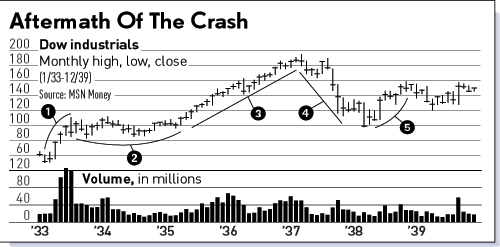The Nasdaq's even for 2004. The Dow has lost ground. This doesn't look like the 1990s -- or like the 2000-02 bear, for that matter.
Welcome to reality. The market doesn't always boom or bust. It frequently sticks to a trading range, known as a sideways market. That doesn't mean there aren't plenty of opportunities for profit. If you strictly follow the buy and sell rules featured in this column and in other IBD features, you stand a better chance of achieving strong gains.
The Nasdaq's run-up and crash in 2000 looked a lot like the Dow in 1929, as IBD has noted. In both cases, an era of technological change and economic growth produced a frothy run-up in stocks.
After the bubble burst, the Dow sank nearly 90% from September 1929 to July 1932. Meanwhile, the U.S. got crushed by bank failures, unemployment and drought.
The market bottomed on July 8, then followed through on Day 4 of its new rally with a 5.2% gain on heavier trade. The Dow doubled in two months, then consolidated its gains. It doubled again in the first half of 1933 (point 1), then entered a two-year trading range that looks similar to this year's market action so far (point 2).
The Dow declined 24% during that stretch. That would ordinarily meet the definition of a new bear market. But given the market's violent swings the prior 10 years, it looks more like a normal correction.
Franklin Roosevelt was inaugurated president in 1933, restoring some optimism to a beleaguered nation. Banking reforms and New Deal policies helped stabilize the stock market despite the ongoing Depression and Dust Bowl crisis.
The Glass-Steagall Act created the FDIC in 1933 to protect banking assets. The Securities & Exchange Commission was formed in 1934, the Social Security system in 1935.
The Dow nearly doubled once more from March 1935 to March 1937 as the economy got back on track (point 3). But it gave up those gains the following year in a sharp, violent slide (point 4) as a new recession pushed unemployment back near 20%.
From March 8 to 22, 1937, the Dow heralded the skid with four distribution days in a little over two weeks. More distributions followed April 2 and 7. The Dow rose 63% from March to November 1938 (point 5), then puttered along the rest of the 1930s, never coming close to recapturing its March 1937 high. It would take an infusion of military spending in the 1940s to fully revive the market.

